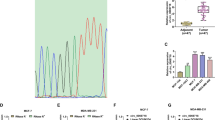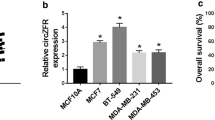Abstract
Circular RNAs (circRNAs) have been reported to paly roles in the progression and management of breast cancers (BC). This work aimed to detect the role and mechanism of circ_0008717 in BC tumorigenesis. Expression levels of genes and proteins were evaluated by quantitative real-time polymerase chain reaction and western blot. In vitro assays were conducted using cell counting kit-8, colony formation, transwell, tube formation, and flow cytometry assays, respectively. The interaction between miR-326 and circ_0008717 or GATA6 (GATA Binding Protein six) was confirmed by bioinformatics analysis, and dual-luciferase reporter assay and RNA immunoprecipitation assay. The murine xenograft models were established to perform in vivo assay. Circ_0008717 and GATA6 were highly expressed, while miR-326 was lowly expressed in BC tissues and cells. Functionally, knockdown of circ_0008717 not only suppressed breast cancer cell proliferation, angiogenesis, migration, invasion and epithelial–mesenchymal transition (EMT) in vitro, but also hindered tumor growth and EMT process in vivo. Mechanistically, Circ_0008717 directly bound to miR-326, which targeted GATA6. Rescue experiments showed that miR-326 reversed the anticancer action of circ_0008717 knockdown on BC cells. Moreover, miR-326 restoration repressed BC cell growth and metastasis, which were attenuated by GATA6 overexpression. In addition, we also observed that circ_0008717 could regulate GATA6 expression by sponging miR-326. Circ_0008717 promoted breast cancer growth and metastasis through miR-326/GATA6 axis, revealing a potential therapeutic target for breast cancer treatment.









Similar content being viewed by others
Data Availability
The data sets used and/or analyzed during the current study are available from the corresponding author on reasonable request.
References
Abdel Ghafar MT, Soliman NA (2022) Metadherin (AEG-1/MTDH/LYRIC) expression: significance in malignancy and crucial role in colorectal cancer. Adv Clin Chem 106:235–280
Abdel Ghafar MT, Gharib F, Al-Ashmawy GM, Mariah RA (2020) Serum high-temperature-required protein A2: a potential biomarker for the diagnosis of breast cancer. Gene Rep 20:100706
Abdel Ghafar MT, El-Rashidy MA, Gharib F, Al-Ashmawy GM (2021a) Impact of XRCC1 genetic variants on its tissue expression and breast cancer risk: a case-control study. Environ Mol Mutagen 62(7):399–408
Abdel Ghafar MT, Elkhouly RA, Elnaggar MH, Mabrouk MM, Darwish SA, Younis RL et al (2021b) Utility of serum neuropilin-1 and angiopoietin-2 as markers of hepatocellular carcinoma. J Investig Med 69(6):1222–1229
Bray F, Ferlay J, Soerjomataram I, Siegel RL, Torre LA, Jemal A (2018) Global cancer statistics 2018: GLOBOCAN estimates of incidence and mortality worldwide for 36 cancers in 185 countries. CA Cancer J Clin 68(6):394–424
Chen LL, Yang L (2015) Regulation of circRNA biogenesis. RNA Biol 12(4):381–388
Chen RX, Liu HL, Yang LL, Kang FH, Xin LP, Huang LR et al (2019) Circular RNA circRNA_0000285 promotes cervical cancer development by regulating FUS. Eur Rev Med Pharmacol Sci 23(20):8771–8778
Chen W, Chen Z, Zhang M, Tian Y, Liu L, Lan R et al (2020) GATA6 exerts potent lung cancer suppressive function by inducing cell senescence. Front Oncol 10:824
Cong L, Yang Q, Hu C, Yu Q, Hao S, Li D (2019) Current status of functional studies on circular RNAs in bladder cancer and their potential role as diagnostic and prognostic biomarkers: a review. Med Sci Monit 25:3425–3434
Du Y, Shen L, Zhang W, Ding R, Li Q, Li S et al (2019) Functional analyses of microRNA-326 in breast cancer development. Biosci Rep 39(7):BSR20190787
Esquela-Kerscher A, Slack FJ (2006) Oncomirs—microRNAs with a role in cancer. Nat Rev Cancer 6(4):259–269
Ghaemi Z, Soltani BM, Mowla SJ (2019) MicroRNA-326 functions as a tumor suppressor in breast cancer by targeting ErbB/PI3K signaling pathway. Front Oncol 9:653
Habib EM, Nosiar NA, Eid MA, Taha AM, Sherief DE, Hassan AE et al (2021) MiR-150 expression in chronic myeloid leukemia: relation to imatinib response. Lab Med 53(1):58–64
Hansen TB, Jensen TI, Clausen BH, Bramsen JB, Finsen B, Damgaard CK et al (2013) Natural RNA circles function as efficient microRNA sponges. Nature 495(7441):384–388
Kristensen LS, Hansen TB, Venø MT, Kjems J (2018) Circular RNAs in cancer: opportunities and challenges in the field. Oncogene 37(5):555–565
Lai HT, Chiang CT, Tseng WK, Chao TC, Su Y (2020) GATA6 enhances the stemness of human colon cancer cells by creating a metabolic symbiosis through upregulating LRH-1 expression. Mol Oncol 14(6):1327–1347
Liang HF, Zhang XZ, Liu BG, Jia GT, Li WL (2017) Circular RNA circ-ABCB10 promotes breast cancer proliferation and progression through sponging miR-1271. Am J Cancer Res 7(7):1566–1576
Liang X, Li Z, Men Q, Li Y, Li H, Chong T (2018) miR-326 functions as a tumor suppressor in human prostatic carcinoma by targeting Mucin1. Biomed Pharmacother 108:574–583
Liu H, Du F, Sun L, Wu Q, Wu J, Tong M et al (2019a) GATA6 suppresses migration and metastasis by regulating the miR-520b/CREB1 axis in gastric cancer. Cell Death Dis 10(2):35
Liu Z, Zhou Y, Liang G, Ling Y, Tan W, Tan L et al (2019b) Circular RNA hsa_circ_001783 regulates breast cancer progression via sponging miR-200c-3p. Cell Death Dis 10(2):55
Liu M, Luo C, Dong J, Guo J, Luo Q, Ye C et al (2020) CircRNA_103809 suppresses the proliferation and metastasis of breast cancer cells by sponging microRNA-532-3p (miR-532-3p). Front Genet 11:485
Pan YJ, Wan J, Wang CB (2019) MiR-326: promising biomarker for cancer. Cancer Manag Res 11:10411–10418
Peart O (2017) Metastatic breast cancer. Radiol Technol 88(5):519m–539m
Qu Y, Dou P, Hu M, Xu J, Xia W, Sun H (2019) circRNA-CER mediates malignant progression of breast cancer through targeting the miR-136/MMP13 axis. Mol Med Rep 19(4):3314–3320
Shen W, Niu N, Lawson B, Qi L, Zhang J, Li T et al (2019) GATA6: a new predictor for prognosis in ovarian cancer. Hum Pathol 86:163–169
Shen S, Jiang M, Deng W, Liu X, Xiong J, Zeng Z et al (2022) Circ_0008717 promotes renal cell carcinoma progression by upregulating FBXO17 via targeting miR-217. J Gene Med 31:e3418
Siegel RL, Miller KD, Jemal A (2020) Cancer statistics, 2020. CA Cancer J Clin 70(1):7–30
Song Y, Tian T, Fu X, Wang W, Li S, Shi T et al (2015) GATA6 is overexpressed in breast cancer and promotes breast cancer cell epithelial-mesenchymal transition by upregulating slug expression. Exp Mol Pathol 99(3):617–627
Thomson DW, Dinger ME (2016) Endogenous microRNA sponges: evidence and controversy. Nat Rev Genet 17(5):272–283
Wang Y, Mo Y, Gong Z, Yang X, Yang M, Zhang S et al (2017) Circular RNAs in human cancer. Mol Cancer 16(1):25
Wang C, Liu Q, Huang M, Zhou Q, Zhang X, Zhang J et al (2020) Loss of GATA6 expression promotes lymphatic metastasis in bladder cancer. FASEB J 34(4):5754–5766
Wang H, Tang Z, Duan J, Zhou C, Xu K, Mu H (2022) Cancer-released exosomal circular RNA circ_0008717 promotes cell tumorigenicity through microRNA-1287-5p/P21-activated kinase 2 (PAK2) axis in non-small cell lung cancer. Bioengineered 13(4):8937–8949
Xu JZ, Shao CC, Wang XJ, Zhao X, Chen JQ, Ouyang YX et al (2019) circTADA2As suppress breast cancer progression and metastasis via targeting miR-203a-3p/SOCS3 axis. Cell Death Dis 10(3):175
Yang R, Xing L, Zheng X, Sun Y, Wang X, Chen J (2019) The circRNA circAGFG1 acts as a sponge of miR-195-5p to promote triple-negative breast cancer progression through regulating CCNE1 expression. Mol Cancer 18(1):4
Ye Z, Zhu Z, Xie J, Feng Z, Li Y, Xu X et al (2020) Hsa_circ_0000069 knockdown inhibits tumorigenesis and exosomes with downregulated hsa_circ_0000069 suppress malignant transformation via inhibition of STIL in pancreatic cancer. Int J Nanomed 15:9859–9873
Yu J, Xu QG, Wang ZG, Yang Y, Zhang L, Ma JZ et al (2018) Circular RNA cSMARCA5 inhibits growth and metastasis in hepatocellular carcinoma. J Hepatol 68(6):1214–1227
Yu T, Wang Y, Fan Y, Fang N, Wang T, Xu T et al (2019) CircRNAs in cancer metabolism: a review. J Hematol Oncol 12(1):90
Zhang J, He H, Wang K, Xie Y, Yang Z, Qie M et al (2020) miR-326 inhibits the cell proliferation and cancer stem cell-like property of cervical cancer in vitro and oncogenesis in vivo via targeting TCF4. Ann Transl Med 8(24):1638
Acknowledgements
Thanks for all participants involved in this study.
Funding
None.
Author information
Authors and Affiliations
Contributions
YC performed experiments and wrote the manuscript, designed research, performed experiments, and edited the manuscript, LY collected and analyzed data. All authors read and approved the final manuscript.
Corresponding author
Ethics declarations
Competing interest
The authors declare that there are no competing interest associated with the manuscript.
Ethical Approval
All animal experiments were conducted strictly in line with the guidelines approved by the Ethics Committee of West China Second University Hospital and performed in accordance with the guidelines of the National Animal Care and Ethics Institution.
Consent to Participate
All subjects provided written informed consent before this research, and this work was authorized by the Ethics Committee of West China Second University Hospital and was carried out according to the guidelines of Declaration of Helsinki.
Consent for Publication
Not applicable.
Additional information
Publisher's Note
Springer Nature remains neutral with regard to jurisdictional claims in published maps and institutional affiliations.
Supplementary Information
Below is the link to the electronic supplementary material.
10528_2022_10270_MOESM1_ESM.tif
Supplementary file1 (TIF 3744 KB)—IHC staining for GATA6, E-cadherin, N-cadherin and vimentin. IHC detected GATA6, E-cadherin, N-cadherin and vimentin expression in the Xenograft tumors
Rights and permissions
Springer Nature or its licensor holds exclusive rights to this article under a publishing agreement with the author(s) or other rightsholder(s); author self-archiving of the accepted manuscript version of this article is solely governed by the terms of such publishing agreement and applicable law.
About this article
Cite this article
Yang, L., Chen, Y. Circ_0008717 Sponges miR-326 to Elevate GATA6 Expression to Promote Breast Cancer Tumorigenicity. Biochem Genet 61, 578–596 (2023). https://doi.org/10.1007/s10528-022-10270-z
Received:
Accepted:
Published:
Issue Date:
DOI: https://doi.org/10.1007/s10528-022-10270-z




